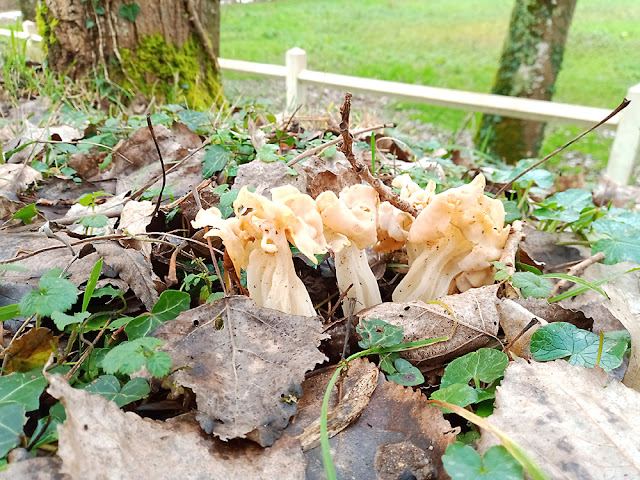White Saddle Mushroom Helvella crispa (Fr. Helvelle crépue).
White Saddle mushrooms are ascomycetes, meaning they don't have gills and are a sort of consistently rubbery substance. They are twisted and fluted and grooved so they present a very distinctive appearance. I'm sure many people encountering them think they are some sort of weird mutation or are old and damaged. But no, this is how they look. They are one of my favourites to spot on a walk (or from the car when driving by as I did with these ones) because they are so unusual looking.
They are whitish all over, with a crinkly cap and multi-stranded 'stem'. The scientific specific name 'crispa' refers to the frilly or wrinkled form of the cap. No doubt because of their striking appearance the species has quite a few vernacular names, in both French and English. You might hear them called 'bonnets de capelan' or 'morilles d'automne' in French, or 'fluted white elfin saddles' in English.
They grow under deciduous trees in damp places, often alongside tracks. The group in these photos is growing on the roadside between the bridges over the Claise at Humeau, under some poplar trees. You could see this species all through the autumn, and these were photographed just a few days ago, in January.
It's a mushroom which has had changing opinions as to whether it is edible or not. It was traditionally eaten in both France and Italy, but then was regarded as toxic. More recently some opinion has swung back to considering it edible. You do need to know that it is definitely toxic if consumed raw or insufficiently cooked. The question now is more that although one toxin is destroyed by thorough cooking, it seems there is a second toxin which is not so easy to deal with.
This second toxin is more random, and sometimes has no effect, but at worst can cause long term neurological damage and even cancer. Historically there has been confusion between this species and a number of others containing similar toxins, which are probably more dangerous. This may explain why tests often show no significant toxins present in H. crispa, and there are very few confirmed cases of poisonings which are definitely this species. The likelihood is that White Saddles are edible, so long as they are blanched in boiling water before being thoroughly cooked in an open pan.





No comments:
Post a Comment